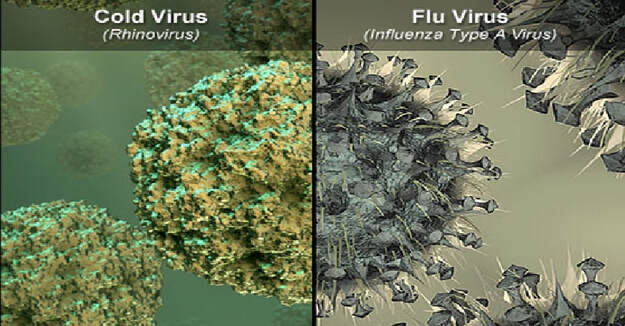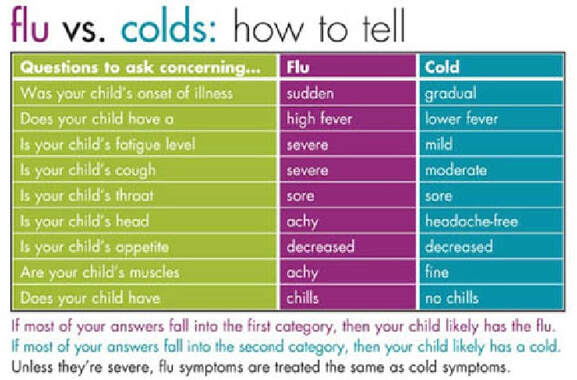
The Truth About Colds and Flu Doctors Won’t Tell You
If you suffer from cold or flu, you may want to let it run its course and rest both physically and emotionally, instead of taking conventional drugs that are supposed to suppress the symptoms.
Conventional medicine claims that there is no “cure” for common cold, and flu should be prevented with vaccines loaded with chemicals. You are also supposed to ease your discomfort with the help of different medications.
Unfortunately, this only indicates a lack of understanding what colds and flu are really like, and their effect on your body.
They are both caused by viruses. You have to understand what viruses can do at cellular level before you understand what colds and flu do at that very same level.
Do you remember your science classes when you learned about cellular division? Each of the cells are parent cells, and through mitosis (genetic duplication) and cytokinesis (cellular division) parent cells divide into daughter cells. Each daughter cell is considered to be a parent cell that will later divide into two daughter cells, and the process goes on.
Viruses, unlike your cells, cannot duplicate through mitosis and cytokinesis. They are microscopic particles of genetic material, and each is coated with a thin protein layer.
Viruses cannot reproduce on their own, as they are not designed to do so. The only way to manage flourishing in your body is to use the machinery and metabolism of your cells, and then produce copies of themselves.
Once viruses access your cells, of course, depending on the type of the virus that is involved, two things can happen:
1. The virus uses cell’s resources to replicate many times. It later breaks open the cell, and the newly replicated viruses leave and search for new cells to infect. This is called lysis, and it effectively kills the cell.
2. The virus incorporates in the DNA of the cell, so it can be passed on to the daughter cells that stem from that cell. Later on, the virus in every daughter cell replicates itself as we already described. The cell is lysed once there are multiple copies of the virus.
As you can see, the infected cell dies due to lysis in both cases.
Why colds and flu can be good for you when allowed to run their course
Viruses responsible for colds and flu mostly infect the weakest cells, usually cells that are burdened with excessive waste and toxins. You should get rid of such cells anyway, and replace them with new and healthy cells.
Colds and flu can be considered as a natural event that allows your body eliminate old and damaged cells. If there is no viral infection, it would take much longer for such cells to be identified, destroyed and eliminated.
Just imagine the “stuff” you blow out of your nose when you have a cold or flu, followed by all the dead cells in the mucous, due to the lytic effect viruses have.
As you can see, there is no need of cure for common cold. It is nature’s way to keep you healthy. Get plenty of rest, eat well and stay hydrated during colds and flu, and you do not need all those vaccines or heavy medications that suppress congested sinuses, fever or cough.
Each of these uncomfortable symptoms is a way through which your body eliminates waste material and goes through colds and flu. It is okay to use over-the-counter pain medication like acetaminophen in cases when the discomfort becomes intolerable, or if these medications help you sleep well.
However, try to avoid medications that suppress helpful processes like fever, cough and runny nose.
But, just because colds and flu help your body does not mean that you should expose yourself to them to improve your health. Protect your health and improve your immune system, get enough sleep and introduce some health-promoting dietary and lifestyle changes.
This will help your cells stay strong against viruses that knock on their membranes. In that case your body will not have enough weak cells available for the colds or flu to do their job and lyse them.
How to differentiate common cold and flu?
Colds come on gradually, within a day or two. You feel tired, sneeze, cough and have a runny nose. In most cases, you do not have a fever, but if you still have it, it is slightly higher than normal. A cold will last for 3-4 days, but sometimes even 10-14 days.
Flu comes suddenly, and it is more serious. It leaves you tired, weak, with a fever as high as 104f. Muscle and joint pain, severe headache, sore throat and a feeling of being chilled are just some of the symptoms. It would take much effort to get off the bed. The fever lasts 3-5 days, but you will feel weak and tired for 2-3 weeks.
Final Note
You do not need any antibiotics, because common colds and flu are caused by viruses. People who take these feel slightly better because antibiotics provide a mild anti-inflammatory effect.
But, the side-effects sure outweigh the benefits. Antibiotics affect friendly bacteria in the digestive tract. If you really need some help when dealing with pain during colds or flu, take a small dose of acetaminophen instead of antibiotics.
If you suffer from cold or flu, you may want to let it run its course and rest both physically and emotionally, instead of taking conventional drugs that are supposed to suppress the symptoms.
Conventional medicine claims that there is no “cure” for common cold, and flu should be prevented with vaccines loaded with chemicals. You are also supposed to ease your discomfort with the help of different medications.
Unfortunately, this only indicates a lack of understanding what colds and flu are really like, and their effect on your body.
They are both caused by viruses. You have to understand what viruses can do at cellular level before you understand what colds and flu do at that very same level.
Do you remember your science classes when you learned about cellular division? Each of the cells are parent cells, and through mitosis (genetic duplication) and cytokinesis (cellular division) parent cells divide into daughter cells. Each daughter cell is considered to be a parent cell that will later divide into two daughter cells, and the process goes on.
Viruses, unlike your cells, cannot duplicate through mitosis and cytokinesis. They are microscopic particles of genetic material, and each is coated with a thin protein layer.
Viruses cannot reproduce on their own, as they are not designed to do so. The only way to manage flourishing in your body is to use the machinery and metabolism of your cells, and then produce copies of themselves.
Once viruses access your cells, of course, depending on the type of the virus that is involved, two things can happen:
1. The virus uses cell’s resources to replicate many times. It later breaks open the cell, and the newly replicated viruses leave and search for new cells to infect. This is called lysis, and it effectively kills the cell.
2. The virus incorporates in the DNA of the cell, so it can be passed on to the daughter cells that stem from that cell. Later on, the virus in every daughter cell replicates itself as we already described. The cell is lysed once there are multiple copies of the virus.
As you can see, the infected cell dies due to lysis in both cases.
Why colds and flu can be good for you when allowed to run their course
Viruses responsible for colds and flu mostly infect the weakest cells, usually cells that are burdened with excessive waste and toxins. You should get rid of such cells anyway, and replace them with new and healthy cells.
Colds and flu can be considered as a natural event that allows your body eliminate old and damaged cells. If there is no viral infection, it would take much longer for such cells to be identified, destroyed and eliminated.
Just imagine the “stuff” you blow out of your nose when you have a cold or flu, followed by all the dead cells in the mucous, due to the lytic effect viruses have.
As you can see, there is no need of cure for common cold. It is nature’s way to keep you healthy. Get plenty of rest, eat well and stay hydrated during colds and flu, and you do not need all those vaccines or heavy medications that suppress congested sinuses, fever or cough.
Each of these uncomfortable symptoms is a way through which your body eliminates waste material and goes through colds and flu. It is okay to use over-the-counter pain medication like acetaminophen in cases when the discomfort becomes intolerable, or if these medications help you sleep well.
However, try to avoid medications that suppress helpful processes like fever, cough and runny nose.
But, just because colds and flu help your body does not mean that you should expose yourself to them to improve your health. Protect your health and improve your immune system, get enough sleep and introduce some health-promoting dietary and lifestyle changes.
This will help your cells stay strong against viruses that knock on their membranes. In that case your body will not have enough weak cells available for the colds or flu to do their job and lyse them.
How to differentiate common cold and flu?
Colds come on gradually, within a day or two. You feel tired, sneeze, cough and have a runny nose. In most cases, you do not have a fever, but if you still have it, it is slightly higher than normal. A cold will last for 3-4 days, but sometimes even 10-14 days.
Flu comes suddenly, and it is more serious. It leaves you tired, weak, with a fever as high as 104f. Muscle and joint pain, severe headache, sore throat and a feeling of being chilled are just some of the symptoms. It would take much effort to get off the bed. The fever lasts 3-5 days, but you will feel weak and tired for 2-3 weeks.
Final Note
You do not need any antibiotics, because common colds and flu are caused by viruses. People who take these feel slightly better because antibiotics provide a mild anti-inflammatory effect.
But, the side-effects sure outweigh the benefits. Antibiotics affect friendly bacteria in the digestive tract. If you really need some help when dealing with pain during colds or flu, take a small dose of acetaminophen instead of antibiotics.
****************************************************************************************

 RSS Feed
RSS Feed